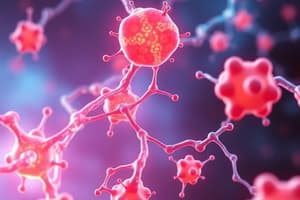Podcast
Questions and Answers
Which mechanism of action is primarily associated with β1 adrenergic receptor activation?
Which mechanism of action is primarily associated with β1 adrenergic receptor activation?
- Vasodilation
- Nausea
- Increased heart rate (correct)
- Bronchodilation
What is a common clinical use for α1 agonists?
What is a common clinical use for α1 agonists?
- Treatment of asthma
- Management of cardiac arrest
- Treatment of ADHD
- Relief of nasal congestion (correct)
Which side effect is NOT commonly associated with sympathomimetic drugs?
Which side effect is NOT commonly associated with sympathomimetic drugs?
- Hypertension
- Anxiety
- Tachycardia
- Weight gain (correct)
Which drug interaction can lead to a hypertensive crisis when sympathomimetics are used?
Which drug interaction can lead to a hypertensive crisis when sympathomimetics are used?
Which type of sympathomimetic has both direct and indirect actions?
Which type of sympathomimetic has both direct and indirect actions?
Flashcards are hidden until you start studying
Study Notes
Mechanism of Action
- Sympathomimetic drugs mimic the effects of sympathetic nervous system stimulation.
- Primarily act on adrenergic receptors: alpha (α) and beta (β).
- Activation of these receptors leads to:
- Increased heart rate (β1 activation).
- Bronchodilation (β2 activation).
- Vasoconstriction or vasodilation depending on receptor subtype (α1/α2, β2).
- Increased glucose metabolism (β2 activation).
Clinical Uses
- Treatment of asthma and COPD (β2 agonists).
- Management of cardiac arrest (epinephrine).
- Relief of nasal congestion (α1 agonists).
- Treatment of hypotension or shock (norepinephrine).
- Attention-deficit hyperactivity disorder (ADHD) (some stimulants).
- Anaphylaxis treatment (epinephrine).
Side Effects
- Cardiovascular: hypertension, tachycardia, palpitations.
- CNS: anxiety, restlessness, insomnia.
- Respiratory: bronchospasm (in sensitive individuals).
- Gastrointestinal: nausea, vomiting.
- Potential for abuse or dependence, particularly with stimulant types.
Drug Interactions
- Monoamine oxidase inhibitors (MAOIs): can lead to hypertensive crisis.
- Tricyclic antidepressants: may enhance sympathomimetic effects.
- Beta-blockers: can reduce the effectiveness of sympathomimetics.
- Vasopressors: increased risk of hypertension when used concurrently.
- Other stimulants: additive effects may occur.
Types Of Sympathomimetics
-
Direct-acting sympathomimetics:
- Bind directly to adrenergic receptors.
- Examples: epinephrine, norepinephrine, dopamine.
-
Indirect-acting sympathomimetics:
- Increase the release of norepinephrine or inhibit its reuptake.
- Examples: amphetamines, cocaine.
-
Mixed-acting sympathomimetics:
- Have both direct and indirect actions.
- Example: ephedrine.
-
Selective sympathomimetics:
- Target specific adrenergic receptor subtypes.
- Examples: albuterol (β2 selective), phenylephrine (α1 selective).
Mechanism of Action
- Sympathomimetic drugs simulate sympathetic nervous system effects.
- Primarily act on adrenergic receptors: alpha (α) and beta (β).
- Activation of β1 receptors increases heart rate.
- β2 receptor activation causes bronchodilation and enhances glucose metabolism.
- Vasoconstriction or vasodilation occurs based on the specific receptor subtype activated (α1, α2, β2).
Clinical Uses
- β2 agonists are used in the management of asthma and chronic obstructive pulmonary disease (COPD).
- Epinephrine is the drug of choice for cardiac arrest management.
- α1 agonists provide relief for nasal congestion.
- Norepinephrine is administered for hypotension and shock.
- Certain stimulants are prescribed for attention-deficit hyperactivity disorder (ADHD).
- Epinephrine also serves as a treatment for anaphylaxis.
Side Effects
- Cardiovascular side effects include hypertension, tachycardia, and palpitations.
- Central nervous system (CNS) effects may involve anxiety, restlessness, and insomnia.
- Respiratory issues can include bronchospasm, particularly in sensitive individuals.
- Gastrointestinal side effects include nausea and vomiting.
- Stimulant forms have potential for abuse and dependence.
Drug Interactions
- Monoamine oxidase inhibitors (MAOIs) can cause a hypertensive crisis when taken with sympathomimetics.
- Co-administration with tricyclic antidepressants may amplify sympathomimetic effects.
- Beta-blockers may diminish the efficacy of sympathomimetic agents.
- Using vasopressors concurrently raises the risk of hypertension.
- Other stimulant drugs can lead to additive effects when combined.
Types Of Sympathomimetics
- Direct-acting sympathomimetics: Bind directly to adrenergic receptors. Examples include epinephrine, norepinephrine, and dopamine.
- Indirect-acting sympathomimetics: Facilitate norepinephrine release or inhibit its reuptake, exemplified by amphetamines and cocaine.
- Mixed-acting sympathomimetics: Exhibit both direct and indirect actions; ephedrine is a key example.
- Selective sympathomimetics: Target specific adrenergic receptor subtypes; examples include albuterol (β2 selective) and phenylephrine (α1 selective).
Studying That Suits You
Use AI to generate personalized quizzes and flashcards to suit your learning preferences.




